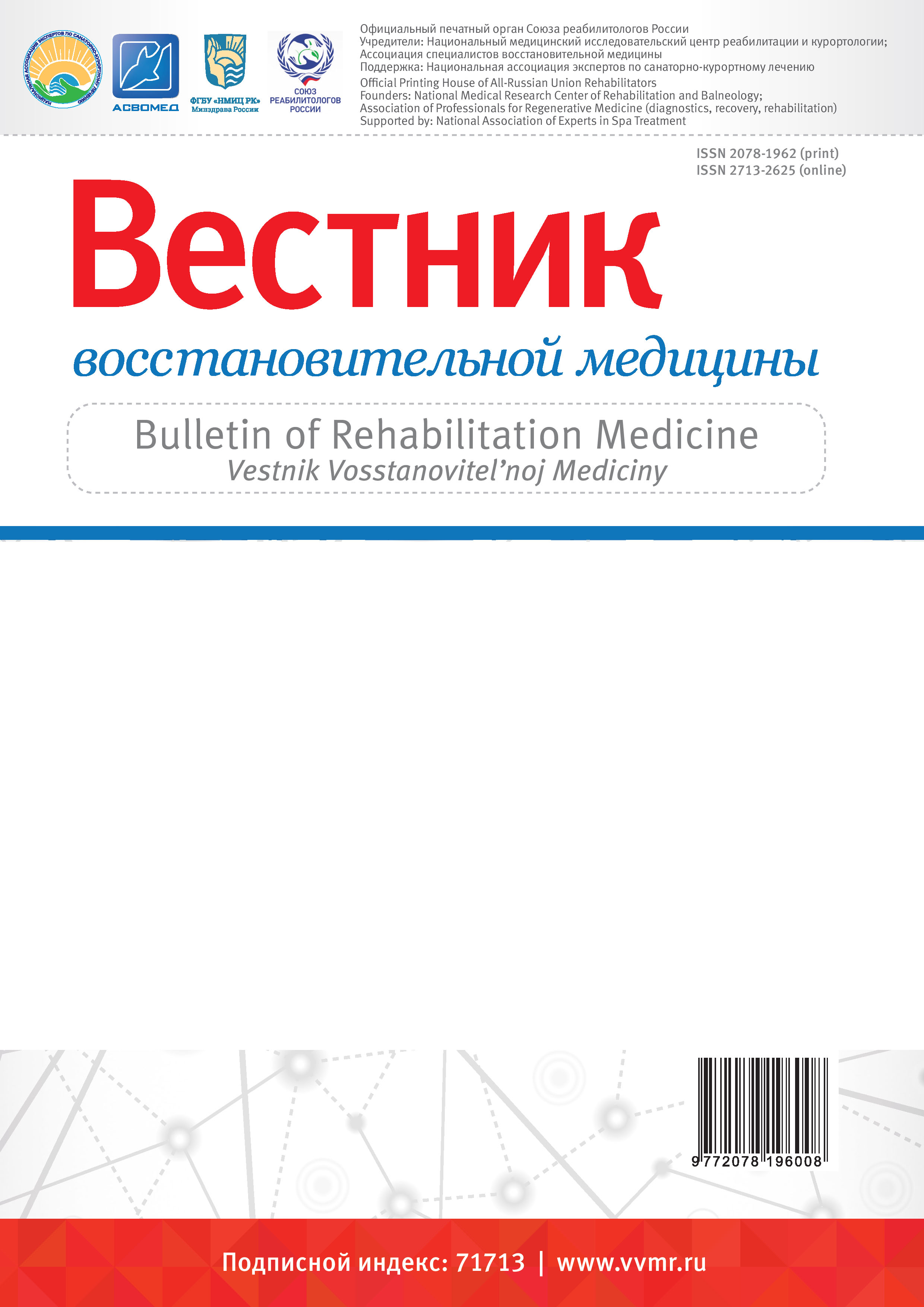В мире на январь 2022 г. зафиксировано 343 млн. случаев заражения SARS-CoV-2. COVID-19 является многогранным, мультисистемным заболеванием, к которому восприимчивы все возрастные группы. Результаты ряда исследований показали, что COVID- 19 сопровождается дисбактериозом, провоцирующим развитие патологий как локального, так и системного характера. Найдено, что использование пробиотиков в комплексной терапии пациентов с COVID-19 снижает тяжесть заболевания и развитие осложнений. По мнению исследователей, терапевтический эффект пробиотиков может быть обусловлен несколькими механизмами, в том числе их способностью ингибировать образование провоспалительных цитокинов и модулировать функциональную активность иммунной системы. В России пробиотики при лечении пациентов с COVID-19 используются только с целью коррекции диареи, между тем, данные литературы указывают на то, что пробиотики обладают значительно большим терапевтическим потенциалом. Для внедрения пероральной бактериотерапии в курс лечения и реабилитации пациентов с COVID-19 требуется проведение новых клинических исследований.
COVID-19, пробиотики, бифидобактерии, лактобактерии, кишечная микрофлора, воспаление
1. Коронавирус. Статистика коронавируса в России и мире в реальном времени. Доступно на: https://coronavirus-monitor.info/ (дата обращения 25.08.2021)
2. Liu H., Chen S., Liu M., Nie H., Lu H. Comorbid Chronic Diseases are Strongly Correlated with Disease Severity among COVID-19 Patients: A Systematic Review and Meta-Analysis. Aging and Disease. 2020; 11(3): 668-678. https://doi.org/10.14336/AD.2020.0502
3. Eastin C., Eastin T. Risk Factors Associated with Acute Respiratory Distress Syndrome and Death in Patients with Coronavirus Disease 2019 Pneumonia in Wuhan, China. The Journal of Emergency Medicine. 2020; 58(4): 713-714. https://doi.org/10.1016/J.JEMERMED.2020.04.007
4. Huang C., Wang Y., Li X. et al. Clinical features of patients infected with 2019 novel coronavirus in Wuhan, China. The Lancet. 2020; 395(10223): 497- 506. https://doi.org/10.1016/S0140-6736(20)30183-5
5. Qiurong R., Kun Y., Wenxia W., Lingyu J., Jianxin S. Clinical predictors of mortality due to COVID-19 based on an analysis of data of 150 patients from Wuhan, China. Intensive Care Medicine. 2020; 46(5): 846-848. https://doi.org/10.1007/S00134-020-05991-X
6. Hu J., Zhang L., Lin W., Tang W., Chan F.K.L., Ng S.C. Review article: Probiotics, prebiotics and dietary approaches during COVID-19 pandemic. Trends in Food Science & Technology. 2021; (108): 187-196. https://doi.org/10.1016/J.TIFS.2020.12.009
7. Aktas B. Gut Microbiota Dysbiosis and COVID-19: Possible Links. Comprehensive Gut Microbiota. 2021; 9(1): 1-9. https://doi.org/10.1016/B978-0-12-819265-8.00072-3
8. Meng G., Wanyin T., Richard A.F., Shu Z. Potential intestinal infection and faecal-oral transmission of SARS-CoV-2. Nature Reviews Gastroenterology & Hepatology. 2021; 18(4): 269-283. https://doi.org/10.1038/S41575-021-00416-6
9. Lin L., Jiang X., Zhang Z. et al. Gastrointestinal symptoms of 95 cases with SARS-CoV-2 infection. Gut. 2020; 69(6): 997-1001. https://doi.org/10.1136/GUTJNL-2020-321013
10. Song Y., Liu P., Shi X.L. et al. SARS-CoV-2 induced diarrhoea as onset symptom in patient with COVID-19. Gut. 2020; 69(6): 1143-1144. https://doi.org/10.1136/GUTJNL-2020-320891
11. Jin X., Lian J.S., Hu J.H. et al. Epidemiological, clinical and virological characteristics of 74 cases of coronavirus-infected disease 2019 (COVID-19) with gastrointestinal symptoms. Gut. 2020; 69(6): 1002-1009. https://doi.org/10.1136/GUTJNL-2020-320926
12. Pan L., Mu M., Yang P. et al. Clinical Characteristics of COVID-19 Patients with Digestive Symptoms in Hubei, China: A Descriptive, Cross-Sectional, Multicenter Study. The American Journal of Gastroenterology. 2020; 115(5): 766-773. https://doi.org/10.14309/AJG.0000000000000620
13. Wan Y., Li J., Shen L. et al. Enteric involvement in hospitalised patients with COVID-19 outside Wuhan. The Lancet Gastroenterology & Hepatology. 2020; 5(6): 534-535. https://doi.org/10.1016/S2468-1253(20)30118-7
14. Ichinohe T., Pang I., Kumamoto Y. et al. Microbiota regulates immune defense against respiratory tract influenza A virus infection. Proceedings of the National Academy of Sciences of the United States of America. 2011; 108(13): 5354-5359. https://doi.org/10.1073/PNAS.1019378108
15. Shenderov B.A. Metabiotics: novel idea or natural development of probiotic conception. Microbial Ecology in Health & Disease. 2013; 24(0): 44-49. https://doi.org/10.3402/MEHD.V24I0.20399
16. Hooper L., Gordon J. Commensal host-bacterial relationships in the gut. Science. 2001; 292(5519): 1115-1118. https://doi.org/10.1126/SCIENCE.1058709
17. Chervonsky A. Innate receptors and microbes in induction of autoimmunity. Current Opinion in Immunology. 2009; 21(6): 641-647. https://doi.org/10.1016/J.COI.2009.08.003
18. King S., Glanville J., Sanders M., Fitzgerald A., Varley D. Effectiveness of probiotics on the duration of illness in healthy children and adults who develop common acute respiratory infectious conditions: a systematic review and meta-analysis. The British Journal of Nutrition. 2014; 112(1): 41-54. https://doi.org/10.1017/S0007114514000075
19. Qiukui H., Bi R.D., Taixiang W. Probiotics for preventing acute upper respiratory tract infections. The Cochrane Database of Systematic Reviews. 2015; 2015(2): 3 p. https://doi.org/10.1002/14651858.CD006895.PUB3
20. Chong H. X., Asmaa N., Yusoff A. et al. Lactobacillus plantarum DR7 improved upper respiratory tract infections via enhancing immune and inflammatory parameters: A randomized, double-blind, placebo-controlled study. Journal of Dairy Science. 2019; 102(6): 4783-4797. https://doi.org/10.3168/JDS.2018-16103
21. Mechanick J. I., Carbone S., Dickerson R. N. et al. Clinical Nutrition Research and the COVID-19 Pandemic: A Scoping Review of the ASPEN COVID-19 Task Force on Nutrition Research. Journal of Parenteral and Enteral Nutrition. 2021; 45(1): 13-31. https://doi.org/10.1002/JPEN.2036
22. Infusino F., Marazzato M., Mancone M. et al. Diet Supplementation, Probiotics, and Nutraceuticals in SARS-CoV-2 Infection: A Scoping Review. Nutrients. 2020; 12(6): 1-21. https://doi.org/10.3390/NU12061718
23. Sanders M.E., Merenstein D.J., Ouwehand A.C. et al. Probiotic use in at-risk populations. Journal of the American Pharmacists Association. 2016; 56(6): 680-686. https://doi.org/10.1016/J.JAPH.2016.07.001
24. d’Ettorre G., Ceccarelli G., Marazzato M. et al. Challenges in the Management of SARS-CoV2 Infection: The Role of Oral Bacteriotherapy as Complementary Therapeutic Strategy to Avoid the Progression of COVID-19. Frontiers in Medicine. 2020; (1): 389 p. https://doi.org/10.3389/fmed.2020.00389
25. Dermyshi E., Wang Y., Yan C. et al. The “Golden Age” of Probiotics: A Systematic Review and Meta-Analysis of Randomized and Observational Studies in Preterm Infants. Neonatology. 2017; 112(1): 9-23. https://doi.org/10.1159/000454668
26. Hill C., Guarner F., Reid G. et al. Expert consensus document: The international scientific association for probiotics and prebiotics consensus statement on the scope and appropriate use of the term probiotic. Nature Reviews Gastroenterology and Hepatology. 2014; 11(8): 506-514. https://doi.org/10.1038/NRGASTRO.2014.66
27. Gao Q.Y., Chen Y.X., Fang J.Y. 2019 Novel coronavirus infection and gastrointestinal tract. Journal of Digestive Diseases. 2020; 21(3): 125-126. https://doi.org/10.1111/1751-2980.12851






